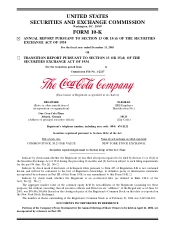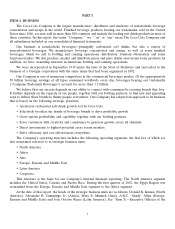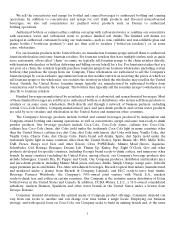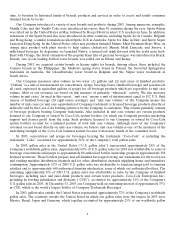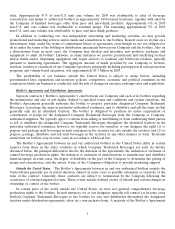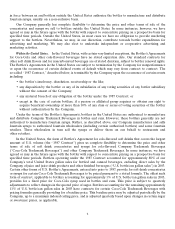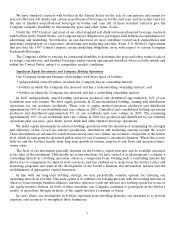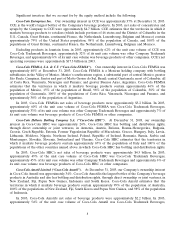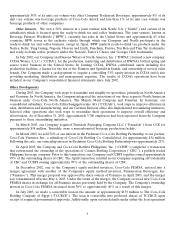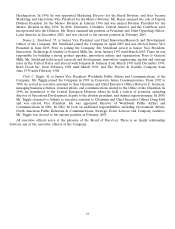Coca Cola 2003 Annual Report Download - page 11
Download and view the complete annual report
Please find page 11 of the 2003 Coca Cola annual report below. You can navigate through the pages in the report by either clicking on the pages listed below, or by using the keyword search tool below to find specific information within the annual report.Significant investees that we account for by the equity method include the following:
Coca-Cola Enterprises Inc. Our ownership interest in CCE was approximately 37% at December 31, 2003.
CCE is the world’s largest bottler of the Company’s beverage products. In 2003, net sales of concentrates and
syrups by the Company to CCE were approximately $4.7 billion. CCE estimates that the territories in which it
markets beverage products to retailers (which include portions of 46 states and the District of Columbia in the
U.S., Canada, Great Britain, continental France, the Netherlands, Luxembourg, Belgium and Monaco) contain
approximately 79% of the United States population, 98% of the population of Canada, and 100% of the
populations of Great Britain, continental France, the Netherlands, Luxembourg, Belgium and Monaco.
Excluding products in fountain form, in 2003, approximately 62% of the unit case volume of CCE was
Coca-Cola Trademark Beverages, approximately 32% of its unit case volume was other Company Trademark
Beverages, and approximately 6% of its unit case volume was beverage products of other companies. CCE’s net
operating revenues were approximately $17.3 billion in 2003.
Coca-Cola FEMSA, S.A. de C.V. (‘‘Coca-Cola FEMSA’’). Our ownership interest in Coca-Cola FEMSA was
approximately 40% at December 31, 2003. Coca-Cola FEMSA is a Mexican holding company with bottling
subsidiaries in the Valley of Mexico, Mexico’s southeastern region, a substantial part of central Mexico; greater
S˜
ao Paulo, Campinas, Santos and part of Matto Grosso do Sul, Brazil; central Guatemala; most of Colombia; all
of Costa Rica, Venezuela, Nicaragua and Panama; and greater Buenos Aires, Argentina. Coca-Cola FEMSA
estimates that the territories in which it markets beverage products contain approximately 46% of the
population of Mexico, 15% of the population of Brazil, 98% of the population of Colombia, 38% of the
population of Guatemala, 100% of the populations of Costa Rica, Venezuela, Nicaragua and Panama, and
approximately 30% of the population of Argentina.
In 2003, Coca-Cola FEMSA’s net sales of beverage products were approximately $3.2 billion. In 2003,
approximately 60% of the unit case volume of Coca-Cola FEMSA was Coca-Cola Trademark Beverages,
approximately 33% of its unit case volume was other Company Trademark Beverages and approximately 7% of
its unit case volume was beverage products of Coca-Cola FEMSA or other companies.
Coca-Cola Hellenic Bottling Company S.A. (‘‘Coca-Cola HBC’’). At December 31, 2003, our ownership
interest in Coca-Cola HBC was approximately 24%. Coca-Cola HBC has bottling and distribution rights,
through direct ownership or joint ventures, in Armenia, Austria, Belarus, Bosnia-Herzegovina, Bulgaria,
Croatia, Czech Republic, Estonia, Former Yugoslavian Republic of Macedonia, Greece, Hungary, Italy, Latvia,
Lithuania, Moldova, Nigeria, Northern Ireland, Poland, Republic of Ireland, Romania, Russia, Serbia and
Montenegro, Slovakia, Slovenia, Switzerland and Ukraine. Coca-Cola HBC estimates that the territories in
which it markets beverage products contain approximately 67% of the population of Italy and 100% of the
populations of the other countries named above in which Coca-Cola HBC has bottling and distribution rights.
In 2003, Coca-Cola HBC’s net sales of beverage products were approximately $4.5 billion. In 2003,
approximately 49% of the unit case volume of Coca-Cola HBC was Coca-Cola Trademark Beverages,
approximately 45% of its unit case volume was other Company Trademark Beverages and approximately 6% of
its unit case volume was beverage products of Coca-Cola HBC or other companies.
Coca-Cola Amatil Limited (‘‘Coca-Cola Amatil’’). At December 31, 2003, our Company’s ownership interest
in Coca-Cola Amatil was approximately 34%. Coca-Cola Amatil is the largest bottler of the Company’s beverage
products in Australia and also has bottling and distribution rights, through direct ownership or joint ventures, in
New Zealand, Fiji, Papua New Guinea, Indonesia and South Korea. Coca-Cola Amatil estimates that the
territories in which it markets beverage products contain approximately 99% of the population of Australia,
100% of the populations of New Zealand, Fiji, South Korea and Papua New Guinea, and 98% of the population
of Indonesia.
In 2003, Coca-Cola Amatil’s net sales of beverage products were approximately $2.2 billion. In 2003,
approximately 54% of the unit case volume of Coca-Cola Amatil was Coca-Cola Trademark Beverages,
8

